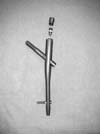Abstract
Purpose
This study was conducted in order to demonstrate the radiologic and clinical results of using the Asian type gamma 3 nail in treatment of trochanteric fractures.
Materials and Methods
Patients underwent operations with gamma 3 nails between August 2010 and August 2012. For the radiologic evaluation, we analyzed bone quality, fracture pattern, reduction quality, union period, and position of lag screw (tip-apex distance, Cleveland index). For the clinical evaluation, we analyzed mobility score of Palmer and Parker and Jensen's functional score.
Figures and Tables
 | Fig. 2The patient is an 84-year-old female. (A, B) Preoperative radiograph shows an unstable fracture, AO A22. (C, D) Immediate postoperative x-ray shows relatively good reduction, but a lag screw was eccentrically positioned. |
 | Fig. 3
(A) Radiograph shows a typical cut out of the femoral head at three months after the operation. (B) Cross table lateral x-ray. |
 | Fig. 4A 67-year-old female's hip shows AO type 32. (A, B) Preoperative radiograph shows a reverse pattern trochanteric fracture. (C, D) Postoperative x-ray shows unsatisfied reduction of the fracture. |
 | Fig. 5
(A, B) Lag screw was cut out of the femoral head three months after the operation. (C, D) We converted bipolar hemiarthroplasty after removal of the gamma nail. |
References
2. Bridle SH, Patel AD, Bircher M, Calvert PT. Fixation of intertrochanteric fractures of the femur. A randomised prospective comparison of the gamma nail and the dynamic hip screw. J Bone Joint Surg Br. 1991; 73:330–334.

3. Chang WS, Zuckerman JD, Kummer FJ, Frankel VH. Biomechanical evaluation of anatomic reduction versus medial displacement osteotomy in unstable intertrochanteric fractures. Clin Orthop Relat Res. 1987; (225):141–146.

4. Haidukewych GJ, Israel TA, Berry DJ. Reverse obliquity fractures of the intertrochanteric region of the femur. J Bone Joint Surg Am. 2001; 83:643–650.

5. Parker MJ, Palmer CR. A new mobility score for predicting mortality after hip fracture. J Bone Joint Surg Br. 1993; 75:797–798.

6. Jensen JS. Determining factors for the mortality following hip fractures. Injury. 1984; 15:411–414.

7. Jensen JS, Sonne-Holm S, Tøndevold E. Unstable trochanteric fractures. A comparative analysis of four methods of internal fixation. Acta Orthop Scand. 1980; 51:949–962.

8. Koval KJ, Zuckerman JD. Hip Fractures: II. Evaluation and treatment of intertrochanteric fractures. J Am Acad Orthop Surg. 1994; 2:150–156.

9. Müller ME, Nazarian S. Classification of fractures of the femur and its use in the A.O. index (author's transl). Rev Chir Orthop Reparatrice Appar Mot. 1981; 67:297–309.
10. Loch DA, Kyle RF, Bechtold JE, Kane M, Anderson K, Sherman RE. Forces required to initiate sliding in second-generation intramedullary nails. J Bone Joint Surg Am. 1998; 80:1626–1631.

11. Chevalley F, Gamba D. Gamma nailing of pertrochanteric and subtrochanteric fractures: clinical results of a series of 63 consecutive cases. J Orthop Trauma. 1997; 11:412–415.

12. Rosenblum SF, Zuckerman JD, Kummer FJ, Tam BS. A biomechanical evaluation of the Gamma nail. J Bone Joint Surg Br. 1992; 74:352–357.

13. Halder SC. The Gamma nail for peritrochanteric fractures. J Bone Joint Surg Br. 1992; 74:340–344.

14. Haynes RC, Pöll RG, Miles AW, Weston RB. Failure of femoral head fixation: a cadaveric analysis of lag screw cut-out with the gamma locking nail and AO dynamic hip screw. Injury. 1997; 28:337–341.

15. Lacroix H, Arwert H, Snijders CJ, Fontijne WP. Prevention of fracture at the distal locking site of the gamma nail. A biomechanical study. J Bone Joint Surg Br. 1995; 77:274–276.

16. Leung KS, Chen CM, So WS, et al. Multicenter trial of modified Gamma nail in East Asia. Clin Orthop Relat Res. 1996; (323):146–154.

17. Oh JK, Hwang JH. Osteoporotic pertrochanteric fracture: IM nailing. J Korean Fract Soc. 2009; 22:56–65.

18. Loch DA, Kyle RF, Bechtold JE, Kane M, Anderson K, Sherman RE. Forces required to initiate sliding in second-generation intramedullary nails. J Bone Joint Surg Am. 1998; 80:1626–1631.

19. Hong KD, Sim JC, Ha SS, Kim TH, Choi YH, Kim JH. Operative treatment with gamma 3 nail in femur intertrochanteric fracture. J Korean Fract Soc. 2011; 24:7–15.

20. Forthomme JP, Costenoble V, Soete P, Docquier J. Treatment of trochanteric fractures of the femur using the gamma nail (apropos of a series of 92 cases). Acta Orthop Belg. 1993; 59:22–29.
21. Friedl W, Colombo-Benkmann M, Dockter S, Machens HG, Mieck U. Gamma nail osteosynthesis of per- and subtrochanteric femoral fractures. 4 years experiences and their consequences for further implant development. Chirurg. 1994; 65:953–963.
22. Goldhagen PR, O'Connor DR, Schwarze D, Schwartz E. A prospective comparative study of the compression hip screw and the gamma nail. J Orthop Trauma. 1994; 8:367–372.

23. Harris WH. Traumatic arthritis of the hip after dislocation and acetabular fractures: treatment by mold arthroplasty. An end-result study using a new method of result evaluation. J Bone Joint Surg Am. 1969; 51:737–755.

25. Min BW, Kang CS, Kang CH. Fixation failure in patients with proximal fractures of the femur treated with a compression hip screw. J Korean Hip Soc. 1998; 10:163–170.
26. Davis TR, Sher JL, Horsman A, Simpson M, Porter BB, Checketts RG. Intertrochanteric femoral fractures. Mechanical failure after internal fixation. J Bone Joint Surg Br. 1990; 72:26–31.

27. Mulholland RC, Gunn DR. Sliding screw plate fixation of intertrochanteric femoral fractures. J Trauma. 1972; 12:581–591.

28. Kyle RF, Cabanela ME, Russell TA, et al. Fractures of the proximal part of the femur. Instr Course Lect. 1995; 44:227–253.

29. Lee KJ, Min BW, Kim SG, Song KS, Bae KC, Cho CH. Results of treating senile osteoporotic peritrochanteric fracture with proximal femoral nail antirotation (PFNA). J Korean Hip Soc. 2009; 21:162–168.





 PDF
PDF ePub
ePub Citation
Citation Print
Print








 XML Download
XML Download